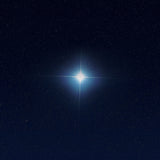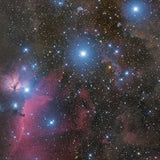Winter Constellations Spotlight: Orion
February 21, 2024


As ancient astronomers looked to the great wintertime constellation of Orion, they saw a hunter holding up a shield or the carcass of a lion in one hand and a club or sword above his head in the other, ready to battle a charging Taurus the Bull. There are several stories about Orion’s mythological origins, but according to one, he was in love with the goddess of the hunt, Artemis. The couple lived in the forest and hunted together. But Artemis’ twin brother, Apollo, did not like Orion and tricked his sister into shooting him with an arrow as he swam, killing him instantly. After Orion’s death, the gods placed him in the night sky after his death as a constellation.
As another legend has it, Orion bragged that he could kill any creature on Earth. His boasting angered the Greek goddess Gaia, Mother Earth. She sent a giant scorpion to put an end to Orion’s life. During their encounter, the scorpion’s poisonous tail stung Orion’s heel, killing him. Zeus, the God of the Sky and Thunder, honored Scorpius by placing it in the sky. Artemis requested that Orion be honored similarly, and Zeus obliged but placed them on opposite ends of the sky. To this day, observers on Earth cannot see the two constellations simultaneously. When Orion rises, Scorpius sets, and vice versa. The pair remain on an endless chase, never to cross paths again.
Orion is one of the 88 modern-day constellations, bordered by Taurus to the northwest, Eridanus to the southwest, Lepus to the south, Canis Major to the southeast, Monoceros to the east, Gemini to the northeast, and joined by his faithful hunting dogs, Canis Major, and Canis Minor. Orion’s bow-tie-like appearance makes it one of the brightest, most popular, and easiest-to-find constellations in the Northern Hemisphere’s Winter sky. And because it lies along the celestial equator, Orion is also visible in the Southern Hemisphere. Stargazers in both hemispheres can see it from November to April, making Orion a worldwide hallmark of the night sky. Let’s discover more about this famous celestial hunter.
Asterism
|
|
Orion is part of the famous Winter Triangle, which is not an official constellation. Three zero-magnitude or brighter stars in three prominent Winter constellations comprise the triangle: Betelgeuse in Orion, Procyon in Canis Minor, and Sirius in Canis Major. Use your imagination and connect the stars to see this cool wintertime triangle of bright stars. No binoculars or telescopes are needed. |
Prominent stars
 |
Rigel, or Beta Orionis, is the brightest star in Orion and is a variable double star. At magnitude 0.13, Rigel is the seventh-brightest star in the sky and near Orion’s left foot. It stands out due to its brilliant blue-white color. Its companion star, Rigel B, is a bluish star at magnitude 6.7 and is challenging to spot since Rigel (A) is over 500 times brighter. |
 |
Betelgeuse, or Alpha Orionis, is a red supergiant and is the second-brightest star in Orion, with a magnitude of 0.45. Betelgeuse is the ninth brightest star in the sky and has a distinct orange/red color. Betelgeuse is between 550 and 920 times the diameter of the Sun. It marks Orion’s right shoulder and recently made headline news when asteroid Leona passed in front of it, causing it to dim briefly. |
 |
Bellatrix, or Gamma Orionis, is a blue-white star, the third-brightest star in Orion, shining at magnitude 1.64. Its name translates from Latin as “the female warrior” and is also known as the “Amazon Star.” You can find Bellatrix on Orion’s left shoulder. |
 |
Saiph, or Kappa Orionis, is a blue-white supergiant and is the sixth-brightest star in Orion. In Arabic, it translates to “sword of the giant.” Saiph lies near Orion’s right knee, the lower left star in Orion’s “bow tie.” |
 |
Alnitak, Alnilam, Mintaka The most recognizable feature of Orion is its three bright stars that make up Orion’s belt – Epsilon, Zeta, and Delta Orionis, better known as Alnitak, Alnilam, and Mintaka in Arabic. According to legend, these three stars make up the stars of the Magi, the Three Wise Men. These three supergiant stars are brighter and more massive than our Sun. Alnitak and Mintaka are multiple-star systems, while Alnilam comprises a single bright star. |
Pointer
 |
You can use the stars of Orion as “pointer stars” to help you navigate the sky and locate other prominent stars and nearby Winter constellations. When you line up Betelgeuse and Bellatrix, they point to Procyon in Canis Minor. Lining up Betelgeuse and Rigel points you towards Pollux and Castor in Gemini. Finally, the belt stars of Alnitak, Alnilam, and Mintaka point toward Sirius in Canis Major and Aldebaran in Taurus. |
Meteor Shower
 |
Orion is home to the annual mid-fall meteor shower, considered one of the most beautiful showers of the year with fast meteors and persistent trains. The Orionids, which peak around October 21, look best in the early morning hours. Meteors appear to radiate from Orion but appear across a large area of the sky. The Orionids are associated with Halley’s Comet and average about 20 meteors per hour. |
Deep-sky Objects
 |
Messier 42 The most celebrated nebula is the Great Nebula in Orion or M42. Located in Orion’s sword, this massive nebula of gas and dust appears like a “cosmic flower” and is only 1,400 light-years away, making it the closest large star-forming region to Earth. With an apparent magnitude of +4, M42 is bright enough that you can see it with the naked eye. Within its nucleus resides the Trapezium, a recent star-forming region in the nebula. Just above M42 is the Running Man Nebula, or NGC 1977. Discovered by William Herschel, the nebula received its name because it resembles a man running with his arms and legs in motion. |
 |
Horsehead Nebula Also referred to as Barnard 33 and IC434, this iconic nebula resides just under the star Alnitak, the easternmost star in Orion’s belt, and is approximately 1500 light years away. This dark nebula resembles a horse’s head and comprises dark clouds of dust and gas. It is a challenging object to view and is best seen in fast, large-aperture telescopes under very dark skies and with a Hydrogen-Beta filter. |
 |
Flame Nebula |
 |
Messier 78 |
 |
Barnard’s Loop |
 |
NGC 2169, or Collinder 83, is a small open cluster near the bend in Orion’s right arm. It is nicknamed the “37 Cluster” due to its uncanny resemblance to the numeral 37. It has an apparent magnitude of 5.9, which puts it within range of binoculars and telescopes. It consists of about 30 stars; its most luminous stars are hot blue B-type stars. This cluster is a popular target for amateur astronomers |
The Winter sky is charming and beautiful, with many brilliant stars, clusters, and nebulae. Use binoculars or a telescope to scan and explore Orion’s belt and sword regions, and you will not be disappointed. Nothing is better than dressing up warmly and enjoying the crisp, clear Winter sky with family and friends, especially after a storm. If possible, head to a dark, rural area away from light pollution for the best observing experience. Astronomy enthusiasts, especially beginning observers, can rejoice, as there are many fantastic targets to observe if you know where to look. Clear skies and happy observing!



























